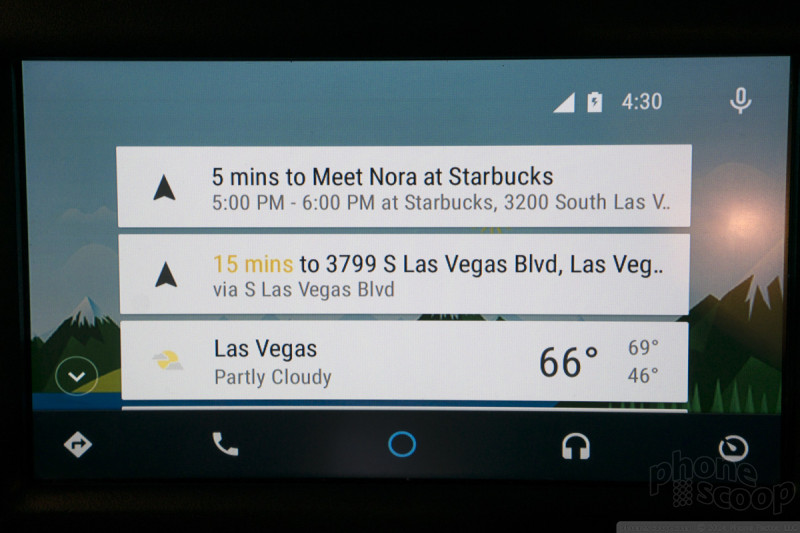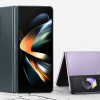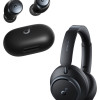CarPlay vs. Android Auto
The features of Android Auto are nearly identical to CarPlay. The main controls are simply a set of buttons across the bottom of the screen for Maps, Phone, and Music.
There is no proper app menu; at first glance, third-party app support is limited to a list of audio services within Google's own Music app.
Android apps can also surface notifications of new messages through Android Auto. Users can have the text of those messages read aloud, and take action by voice, including replies. At the moment, that message-and-reply function enables certain third-party app functionality that doesn't seem possible on Apple's CarPlay. But apps using the reply function don't get an icon, nor any way to invoke them proactively while driving. Want to send a WhatsApp message to a friend while driving? Tough luck, unless they happen to message you first, giving you the opportunity to reply.
Unfortunately, Android Auto's interface seems to preclude more interesting third-party apps; it's not clear where they would fit in without a complete redesign by Google. Third-party app support is extremely limited, and, based on the design, Google aims to keep it that way. That could become a major disadvantage of Android Auto.
Even with the currently-allowed apps, it's confusing to have a podcast app like Joyride available only from within the "Music" part of Android Auto. So the design, while pretty, is not only limiting, but confusing.
Where Android Auto differentiates itself is the home screen, which is based on the excellent Google Now card interface. It's not as immediately intuitive as what Apple has done, as Google is in charge of what you see and when. (Looking for a Messages icon? Good luck.) But if you've used Google Now on an Android phone - or an Android Wear watch - you'll feel right at home. New notifications - such as text messages - appear and can be acted on from this card interface, and it works almost exactly like Android Wear. You'll also find little extra features like weather on the home screen. As with any other place you might interact with Google Now, it's a powerful interface once you master the short learning curve and begin to trust it.
We noticed some bugs in our demos. When composing a message, it would frequently ask for the recipient's name twice, even though it seemed to understand the name the first time. But since the software lives on the phone, new versions of the OS can easily fix these kinds of bugs (the same is true for CarPlay.)
Both CarPlay and Android Auto offer comprehensive map and navigation services, and both attempt a certain amount of intelligence to reduce the need to touch the screen. For example, if someone recently texted you an address, that will automatically be the top navigation suggestion.
It's remarkable how much Android Auto is like Android Wear, and how well that interface works for both scenarios. That's also an area where Google and Apple have diverged in strategy: Google has essentially one interface for any secondary window into your phone. Apple has come up with two radically different solutions for your car and your wrist.
Both Android Auto and CarPlay are currently designed for a traditional rectangular screen. But Sharp was at CES this year showing off its "FreeForm" displays that can be made in any shape, and are aimed squarely at the automobile market. As much as car makers love to differentiate on style, it's not hard to see this technology taking off. And if your next car has a round display in the dash, it's not hard to see how Google might adapt the Android Auto interface to fit it, much as it did with Android Wear for round watches. Unfortunately, it's difficult to see how Apple might adapt the CarPlay interface for different display shapes.
Ultimately, both CarPlay and Android Auto are solid first attempts at linking your car to your phone. They both succeed at bringing a first-rate navigation, communication, and music experience to your dash, with excellent interactive voice control. The experience with either system is leagues better than anything previously available in any car. That alone makes them compelling for any smartphone owner who spends a lot of time in their car. I simply wouldn't consider a new car without one or both.
Curiously, neither has a clear advantage over the other. In spite of small differences, these 1.0 versions perform most of the same functions, and do all of them fairly well. Neither is a compelling reason to choose one smartphone platform over the other; Apple and Google are just keeping pace here. That could change with later versions. It will be interesting to see where Google and Apple steer these platforms down the road.















 Samsung Refines its Foldable Phones
Samsung Refines its Foldable Phones
 SoundCore Debuts new Space Series
SoundCore Debuts new Space Series
 iPhone 14 Plus Offers a Big Screen For Less
iPhone 14 Plus Offers a Big Screen For Less
 Samsung S24 Series Adds More AI, Updates the Hardware
Samsung S24 Series Adds More AI, Updates the Hardware
 Chipolo's New Bluetooth Tracker is Cross-Platform
Chipolo's New Bluetooth Tracker is Cross-Platform





